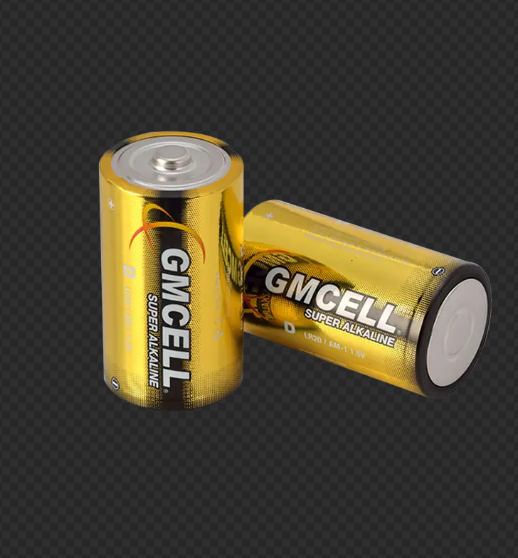D cell batteries, commonly referred to as just D batteries, are a type of cylindrical battery that boasts a larger size and greater energy capacity. They are the solution for devices needing constant power, such as flashlights, radios, and some medical equipment, which just cannot work without them. Founded in 1998, GMCELL is a high-tech battery enterprise specializing in the research and development, production, and sales of batteries, including D cells. GMCELL has built its name and fame during this huge time period, over 25 years, to offer only the best consistent in quality and performance of battery solutions across the world.
What are D Cell Batteries?
D cell batteries can be regarded as one type of the standard size of dry cell batteries, cylindrical in shape, possessing a nominal voltage of 1.5 volts. The d cell battery dimensions are, 61.5 millimeters in length and 34.2 millimeters in diameter, makes it one that is considerably bigger than either AA or AAA batteries. This increased size provides another dimension necessary for assembling larger energy storage: ranging from 8,000 to 20,000 mAh for a specific value depending on chemical composition.
D cells fall into two categories: primary (non-rechargeable) and secondary (rechargeable). The most common batteries found in a primary D battery will be alkaline, zinc-carbon, and lithium, while the secondary ones often include nickel-metal hydride (NiMH) and nickel-cadmium (NiCd) batteries. All these types have their peculiar applications depending upon the device they are used for; hence, great versatility in the application of D batteries.
Common Applications of D Cell Batteries
D cell batteries are renowned for their versatility across multiple applications. Their most popular use is in flashlights, where2 d cell batteries can power a flashlight, providing a steady light output for extended periods. Other common applications include:
- High-Power Consumer Electronics: Devices such as portable stereos, radios, and toys frequently use D cells due to their extended life and energy capacity.
- Medical Devices: Reliable power is critical for medical equipment, including blood glucose monitors and portable oxygen machines, making D cell batteries an essential choice.
- Emergency Preparedness: The long shelf life of D batteries makes them staple items in emergency kits for flashlights and radios, ensuring readiness during power outages.
Moreover, D cells are often used in 6 volt lantern battery verses. For example, while a 6-volt lantern typically requires four C cells, it is also compatible with two D cells when connected in series. This configuration allows the devices to function effectively while utilizing the standard power configuration of D batteries.
D Cell Battery Chemistry and Specifications
The chemistry behind D cell batteries is integral to their effectiveness. Alkaline D batteries utilize a chemical process that combines zinc and manganese dioxide, yielding higher energy capacities and longer shelf lives compared to other types. Meanwhile, zinc-carbon D batteries are typically more affordable; however, they have lower energy capacities and are most effective in low-drain applications.
On the other hand, lithium D batteries offer significant advantages in both capacity and performance, making them suitable for devices that need reliable energy under varying conditions. For instance, lithium batteries maintain their voltage levels longer, ensuring consistent performance in devices like digital cameras and portable audio equipment.
The charge cycles and lifespan of rechargeable D batteries (NiMH or NiCd) can significantly reduce environmental waste, as they can be recharged hundreds of times, thereby lower costs over time. Each type of battery chemistry aligns with specific application requirements and user preferences, guiding consumers in selecting the right battery type for their needs.
Dimensions and Comparison with Other Battery Types
D cell batteries are considerably larger than both C and AA batteries. This height and diameter allow them to store more chemical materials, translating to greater energy output. While a standard AA battery typically has a maximum capacity of around 3,000 mAh, a D battery can deliver capacities substantially higher than 20,000 mAh-this feature is why D batteries are favored for high-drain applications like power tools and medical devices.
Understanding the distinctions among battery sizes is fundamental for consumers. For example, while 2 d cell batteries excel in providing long-lasting power, C batteries are a good choice for devices requiring a balance between size and capacity. Each battery type serves specific needs, emphasizing the importance of employing the correct battery for optimal performance in electronic devices.
The Future of D Cell Batteries
As battery technology continues to evolve, GMCELL remains at the forefront of innovation in the battery industry. With a monthly output exceeding 20 million pieces, GMCELL’s commitment to delivering high-quality, well-designed D cell batteries positions it as a leader in the field. The company’s focus on sustainable practices and product safety ensures that their batteries remain environmentally friendly, meeting consumer demands responsibly. With advancements in technology and a growing need for efficient energy solutions, the relevance of D cell batteries in the market will only increase. From powering everyday devices to essential equipment in emergencies, these batteries demonstrate their vast applications and indispensable nature. As GMCELL continues to enhance its offerings through research and development, D cell batteries are poised to remain an integral part of the energy landscape for years to come. Thus, choosing reliable brands like GMCELL ensures a dependable power source for every need.
Post time: Jan-20-2025






